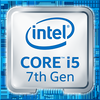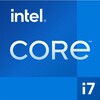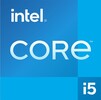Intel Core i5-7600K vs Intel Core i7-1270P vs Intel Core i5-1250P
Intel Core i5-7600K
► remove from comparison
The Intel Core i5-7600K is a fast quad-core processor for desktops based on the Kaby Lake architecture and was announced in January 2017. It is the top model of the consumer Kaby-Lake-H Core i5 series at the time of the announcement. The i5 does not support HyperThreading (4 threads only) and runs from 3.8 (base speed) up to 4.2 GHz. As a K-model, the i5-7600K offers an open multiplicator for overclocking.
Architecture
Intel basically uses the same micro architecture compared to Skylake, so the per-MHz performance does not differ. The manufacturer only reworked the Speed Shift technology for faster dynamic adjustments of voltages and clocks, and the improved 14nm process allows much higher frequencies combined with better efficiency than before.
Performance
The performance of the i5-7600K is about 10 percent above the predecessor Core i5-6600K, thanks to clock speed increases and long hold Turbo Boost clocks. Matching clock speed, there is no speed improvement from Skylake. The old top model Core i7-4790K however is still slightly faster.
More information with gaming benchmarks and power measurements can be found in our AMD Ryzen 7 versus Intel CPUs review (upcoming).
Graphics
The integrated Intel HD Graphics 630 has 24 Execution Units (similar to previous HD Graphics 530) running at 350 - 1150 MHz. The performance depends a lot on the memory configuration; it should be comparable to a dedicated Nvidia GeForce 920M in combination with fast DDR4-2133 dual-channel memory.
Contrary to Skylake, Kaby Lake now supports hardware decoding for H.265/HEVC Main 10 with a 10-bit color depth as well as Google's VP9 codec. The dual-core Kaby Lake processors, which were announced in January, should also support HDCP 2.2.
Power Consumption
The chip is manufactured in an improved 14nm process with FinFET transistors, which improves the efficiency slightly. Intel still specifies the TDP with 91 Watts, which is a lot more than the 45 Watts of the mobile Kaby-Lake-H CPUs.
Intel Core i7-1270P
► remove from comparison
The Intel Core i7-1270P is a higher-end Alder Lake-P family CPU, an expensive 28 W part meant for use in ultra-light, ultra-thin (yet actively cooled) laptops. This CPU was announced in early 2022 and it has 4 performance cores as opposed to the 6 cores of the top-of-the-line 1280P (P-cores, Golden Cove architecture) mated to 8 efficient cores (E-cores, Gracemont architecture). The P-cores are Hyper-Threading-enabled for a total of 16 threads when combined with the E-cores. The clock speeds range from 2.2 GHz to 4.8 GHz for the performance cluster and 1.6 GHz to 3.5 GHz for the efficient cluster. Full vPro feature set is supported by this Core i7 ("Enterprise" tier, allowing for remote device management). Its shortcomings as compared with the mighty i7-1280P include the smaller L3 cache, lower core count, lower clock speeds; the performance is slated to be significantly lower as a result.
A brief look at the specifications instantly reveals this i7 series chip to be very similar to the Core i5-12600H, a more power-hungry processor targeted at gaming laptops.
Architecture
The i7 is a continuation of Intel's efforts to use the ARM-developed big.LITTLE technology for its own benefit. A single "little" Alder Lake core is supposed to be as fast as a Skylake core (as found in the venerable Core i7-6700HQ among other options) which is six years old at this point. All of an Intel Core i7-1270P's CPU cores enjoy access to 18 MB of L3 cache. The integrated memory controller supports various memory types up to LPDDR5-5200, DDR5-4800, LPDDR4x-4267 or DDR4-3200. Intel suggests using no more than 64 GB, for reference. Just like the other 12th Gen Intel Core processors, Core i7-1270P comes with Thread Director which is a new functionality designed to help Windows 11 decide which cores to use for what workload for best performance and efficiency possible. Hardware acceleration of AI algorithms is supported via GNA 3.0 and DL Boost (via AVX2). PCI-Express 5.0 support has not found its way into Alder Lake P processors, so users will have to be content with PCI-Express 4.0 for the time being. Four PCI-Express 4 lanes allow for a read/write rate of up to 7.9 GB/s, provided a suitably fast NVMe SSD is used.
Please note this is not a user-replaceable CPU. It gets soldered permanently on to the motherboard (BGA1744 socket interface).
Performance
The 12 CPU cores are not just able to outshine any outgoing quad-core Tiger Lake part, the i7-1195G7 included. The average 1270P in our database directly competes with the Ryzen 7 5825U, the Ryzen 7 7730U and the Ryzen 7 7735U, meaning this little Core i7 is fast enough to make most consumers happy as of mid 2023.
The fairly high processing power comes at a cost. A single Golden Cove core can consume more than 20 W when under heavy load. Your mileage may thus vary depending on how high the Power Limits are and how competent the cooling solution of your laptop is.
Graphics
The built-in graphics adapter in the form of the 96 EU Iris Xe running at up to 1.40 GHz has seen no change from what was built into the 11th Gen Tiger Lake-UP3 processors, like an i7-1165G7, which is hardly a downside as this iGPU is loaded with modern features such as AV1 video decoding capability and SUHD 4320p monitor support. Up to 4 monitors can be used simultaneously with this iGPU. We expect the gaming performance to be reasonably close to that of NVIDIA's MX350.
In other words, the Xe is good enough for most games at 1080p resolution / Medium settings, provided the Power Limits are high enough and the cooling solution is competent enough. Fast RAM is a prerequisite for decent performance as well (the Xe has to make do with no dedicated video memory).
Last but not the least, we discovered that the GPU utilization when playing YouTube UHD 2160p60 videos is higher than it was with Tiger Lake chips.
Power consumption
The i7's base power consumption (also known as the default TDP or Power Limit 1) is 28 W, with 64 W being its maximum Turbo power consumption (also known as the PL2). As for the "Minimum Assured" power consumption, Intel's guidelines mention 20 W. All in all, an active cooling solution is a must for such a chip.
The CPU is built with Intel's fourth-gen 10 nm process marketed as Intel 7 for decent, as of late 2022, energy efficiency. It's still a rather power-hungry CPU; a single P-core will happily consume more than 20 W when under heavy load. A couple of the higher-end 7 nm U-class AMD Ryzen 5000 chips are not nearly as power-hungry while delivering similar or higher performance levels.
Intel Core i5-1250P
► remove from comparison
The Intel Core i5-1250P is a mid-range Alder Lake-P family SoC designed for use in ultra-light, ultra-thin (yet actively cooled) laptops. It was announced in early 2022 and it has 4 performance cores, as opposed to the 6 cores of the top-of-the-line i7-1280P (P-cores, Golden Cove architecture) mated to 8 efficient cores (E-cores, Gracemont architecture). The i5's P-cores are Hyper-Threading-enabled for a total of 16 threads when combined with its E-cores. The clock speeds range from 1.7 GHz to 4.4 GHz for the performance cluster and 1.2 GHz to 3.3 GHz for the efficient cluster. The shortcomings of this processor as compared with the slightly faster Core i5-1260P include the smaller L3 cache, slower iGPU model, lower clock speeds. Full vPro feature set is enabled in the case of this i5, though ("Enterprise" tier, allowing for remote device management).
Architecture
The i5 is a continuation of Intel's efforts to use the ARM-developed big.LITTLE technology for its own benefit. A single "little" Alder Lake core is supposed to be as fast as a Skylake core (as found in the venerable Core i7-6700HQ among other options) which is six years old at this point. All of Core i5-1250P's CPU cores enjoy access to 12 MB of L3 cache. The integrated memory controller supports various memory types up to LPDDR5-5200, DDR5-4800, LPDDR4x-4267 or DDR4-3200; Intel recommends using no more than 64 GB, for reference. Just like the other 12th Gen Intel Core processors, this Core i5 comes with the Thread Director which is a new functionality designed to help Windows 11 decide which cores to use for what workload for best performance and efficiency possible. Hardware acceleration of AI algorithms is supported via GNA 3.0 and DL Boost (via AVX2). The alluringly fast PCI-Express 5.0 spec has not found its way into Alder Lake P processors, so users will have to be content with PCI-Express 4.0 for the time being. Four PCI-Express 4 lanes allow for a read/write rate of up to 7.9 GB/s, provided a suitably fast NVMe SSD is used.
Please note this is not a user-replaceable CPU. It gets permanently soldered on to the motherboard (FCBGA1744 socket interface).
Performance
The average 1250P in our database nearly matches the Ryzen 5 5500U and the Ryzen 5 PRO 6650U in multi-thread performance, trailing behind the Core i5-1240P just slightly. This is a great CPU for nearly all tasks imaginable, as long as one does not expect it to be as fast as the mighty Core i7-12700H.
Your mileage may vary depending on how high the Power Limits are and how competent the cooling solution of your system is. The latter is really important as a single Golden Cove core can eat more than 20 W when under heavy load.
Graphics
The built-in graphics adapter in the form of the 80 EU Iris Xe running at up to 1.4 GHz has seen little change from what was built into certain 11th Gen Tiger Lake UP3 processors, like a Core i5-1135G7, which is hardly a downside as this iGPU is loaded with modern features, AV1 video decoding capability and SUHD 4320p monitor support included. The Xe isn't a stranger to a bit of casual gaming; that said, your mileage may vary depending on how high the Power Limits are and how capable the cooling solution of a laptop is. Expect something close to NVIDIA's MX250 or in other words, acceptable framerates in most games when playing at 1080p / Low settings. Fast RAM is a prerequisite for decent performance as the Xe has to make do with no dedicated video memory.
Power consumption
The i5's base power consumption (also known as the default TDP or Power Limit 1) is 28 W; its maximum Turbo power consumption (also known as the PL2) is not supposed to exceed 64 W. As for the "Minimum Assured" power consumption, Intel's guidelines mention 20 W. All in all, an active cooling solution is a must for a CPU like this.
The i5-1250P is built with Intel's fourth-gen 10 nm manufacturing process marketed as Intel 7 for decent, as of late 2022, energy efficiency. Despite that, the i5 is more power-hungry than certain 7 nm U-class AMD Ryzen 5000 chips delivering similar, or even higher, performance.
| Model | Intel Core i5-7600K | Intel Core i7-1270P | Intel Core i5-1250P | ||||||||||||||||||||||||||||||||||||||||||||||||||||||||||||||||||||||||||||||||||||||||||||||||||||||||||||||||||||||||||||||||||||||||||||||||||||||||||||||||||||||||||||||||||||||||||||||||||||||||||||||||||||||||
| Codename | Kaby Lake | Alder Lake-P | Alder Lake-P | ||||||||||||||||||||||||||||||||||||||||||||||||||||||||||||||||||||||||||||||||||||||||||||||||||||||||||||||||||||||||||||||||||||||||||||||||||||||||||||||||||||||||||||||||||||||||||||||||||||||||||||||||||||||||
| Series | Intel Kaby Lake | Intel Alder Lake-P | Intel Alder Lake-P | ||||||||||||||||||||||||||||||||||||||||||||||||||||||||||||||||||||||||||||||||||||||||||||||||||||||||||||||||||||||||||||||||||||||||||||||||||||||||||||||||||||||||||||||||||||||||||||||||||||||||||||||||||||||||
| Series: Alder Lake-P Alder Lake-P |
|
|
| ||||||||||||||||||||||||||||||||||||||||||||||||||||||||||||||||||||||||||||||||||||||||||||||||||||||||||||||||||||||||||||||||||||||||||||||||||||||||||||||||||||||||||||||||||||||||||||||||||||||||||||||||||||||||
| Clock | 3800 - 4200 MHz | 1600 - 4800 MHz | 1200 - 4400 MHz | ||||||||||||||||||||||||||||||||||||||||||||||||||||||||||||||||||||||||||||||||||||||||||||||||||||||||||||||||||||||||||||||||||||||||||||||||||||||||||||||||||||||||||||||||||||||||||||||||||||||||||||||||||||||||
| L1 Cache | 256 KB | 1.1 MB | 1.1 MB | ||||||||||||||||||||||||||||||||||||||||||||||||||||||||||||||||||||||||||||||||||||||||||||||||||||||||||||||||||||||||||||||||||||||||||||||||||||||||||||||||||||||||||||||||||||||||||||||||||||||||||||||||||||||||
| L2 Cache | 1 MB | 10 MB | 10 MB | ||||||||||||||||||||||||||||||||||||||||||||||||||||||||||||||||||||||||||||||||||||||||||||||||||||||||||||||||||||||||||||||||||||||||||||||||||||||||||||||||||||||||||||||||||||||||||||||||||||||||||||||||||||||||
| L3 Cache | 8 MB | 18 MB | 12 MB | ||||||||||||||||||||||||||||||||||||||||||||||||||||||||||||||||||||||||||||||||||||||||||||||||||||||||||||||||||||||||||||||||||||||||||||||||||||||||||||||||||||||||||||||||||||||||||||||||||||||||||||||||||||||||
| Cores / Threads | 4 / 4 | 12 / 16 | 12 / 16 | ||||||||||||||||||||||||||||||||||||||||||||||||||||||||||||||||||||||||||||||||||||||||||||||||||||||||||||||||||||||||||||||||||||||||||||||||||||||||||||||||||||||||||||||||||||||||||||||||||||||||||||||||||||||||
| TDP | 91 Watt | 28 Watt | 28 Watt | ||||||||||||||||||||||||||||||||||||||||||||||||||||||||||||||||||||||||||||||||||||||||||||||||||||||||||||||||||||||||||||||||||||||||||||||||||||||||||||||||||||||||||||||||||||||||||||||||||||||||||||||||||||||||
| Technology | 14 nm | 10 nm | 10 nm | ||||||||||||||||||||||||||||||||||||||||||||||||||||||||||||||||||||||||||||||||||||||||||||||||||||||||||||||||||||||||||||||||||||||||||||||||||||||||||||||||||||||||||||||||||||||||||||||||||||||||||||||||||||||||
| Socket | FCLGA1151 | BGA1744 | BGA1744 | ||||||||||||||||||||||||||||||||||||||||||||||||||||||||||||||||||||||||||||||||||||||||||||||||||||||||||||||||||||||||||||||||||||||||||||||||||||||||||||||||||||||||||||||||||||||||||||||||||||||||||||||||||||||||
| Features | DDR3(L)-1600/DDR4-2400 Memory Controller, AVX, AVX2, AES-NI, TSX-NI, Quick Sync, Virtualization, vPro | DDR4-3200/LPDDR4x-4266/DDR5-4800/LPDDR5-5200 RAM, PCIe 4, Thr. Director, DL Boost, GNA, Rem. Platf. Erase, MMX, SSE, SSE2, SSE3, SSSE3, SSE4.1, SSE4.2, AVX, AVX2, BMI2, ABM, FMA, ADX, SMEP, SMAP, EIST, TM1, TM2, HT, Turbo, SST, AES-NI, RDRAND, RDSEED, SHA | DDR4-3200/LPDDR4x-4266/DDR5-4800/LPDDR5-5200, PCIe 4, Thr. Director, DL Boost, GNA, Remote Platform Erase, MMX, SSE, SSE2, SSE3, SSSE3, SSE4.1, SSE4.2, AVX, AVX2, BMI2, ABM, FMA, ADX, SMEP, SMAP, EIST, TM1, TM2, HT, Turbo, SST, AES-NI, RDRAND, RDSEED, SHA | ||||||||||||||||||||||||||||||||||||||||||||||||||||||||||||||||||||||||||||||||||||||||||||||||||||||||||||||||||||||||||||||||||||||||||||||||||||||||||||||||||||||||||||||||||||||||||||||||||||||||||||||||||||||||
| iGPU | Intel HD Graphics 630 (350 - 1150 MHz) | Intel Iris Xe Graphics G7 96EUs ( - 1400 MHz) | Intel Iris Xe Graphics G7 80EUs ( - 1400 MHz) | ||||||||||||||||||||||||||||||||||||||||||||||||||||||||||||||||||||||||||||||||||||||||||||||||||||||||||||||||||||||||||||||||||||||||||||||||||||||||||||||||||||||||||||||||||||||||||||||||||||||||||||||||||||||||
| Architecture | x86 | x86 | x86 | ||||||||||||||||||||||||||||||||||||||||||||||||||||||||||||||||||||||||||||||||||||||||||||||||||||||||||||||||||||||||||||||||||||||||||||||||||||||||||||||||||||||||||||||||||||||||||||||||||||||||||||||||||||||||
| $242 U.S. | |||||||||||||||||||||||||||||||||||||||||||||||||||||||||||||||||||||||||||||||||||||||||||||||||||||||||||||||||||||||||||||||||||||||||||||||||||||||||||||||||||||||||||||||||||||||||||||||||||||||||||||||||||||||||||
| Announced | |||||||||||||||||||||||||||||||||||||||||||||||||||||||||||||||||||||||||||||||||||||||||||||||||||||||||||||||||||||||||||||||||||||||||||||||||||||||||||||||||||||||||||||||||||||||||||||||||||||||||||||||||||||||||||
| Manufacturer | ark.intel.com | ark.intel.com | ark.intel.com | ||||||||||||||||||||||||||||||||||||||||||||||||||||||||||||||||||||||||||||||||||||||||||||||||||||||||||||||||||||||||||||||||||||||||||||||||||||||||||||||||||||||||||||||||||||||||||||||||||||||||||||||||||||||||
| max. Temp. | 100 °C | 100 °C |
Benchmarks
Average Benchmarks Intel Core i5-7600K → 100% n=19
Average Benchmarks Intel Core i7-1270P → 175% n=19
Average Benchmarks Intel Core i5-1250P → 156% n=19
* Smaller numbers mean a higher performance
1 This benchmark is not used for the average calculation












